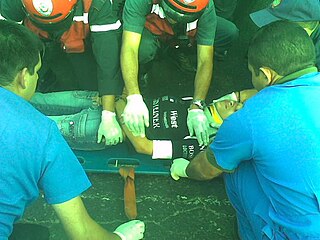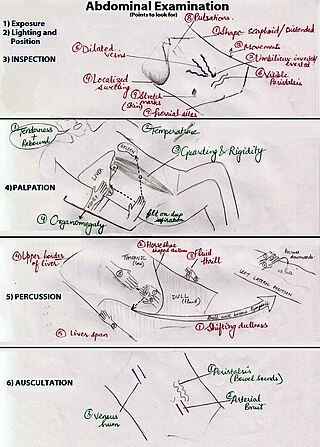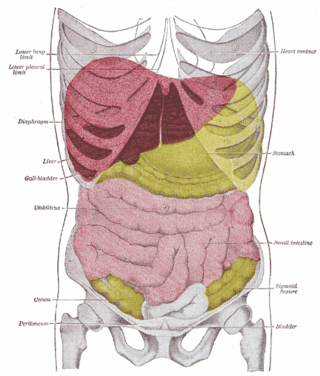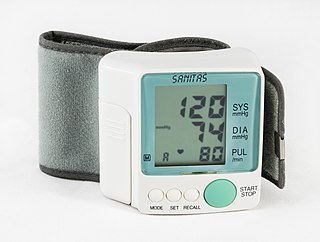Related Research Articles

Auscultation is listening to the internal sounds of the body, usually using a stethoscope. Auscultation is performed for the purposes of examining the circulatory and respiratory systems, as well as the alimentary canal.

In a physical examination, medical examination, or clinical examination, a medical practitioner examines a patient for any possible medical signs or symptoms of a medical condition. It generally consists of a series of questions about the patient's medical history followed by an examination based on the reported symptoms. Together, the medical history and the physical examination help to determine a diagnosis and devise the treatment plan. These data then become part of the medical record.

Palpation is the process of using one's hands to check the body, especially while perceiving/diagnosing a disease or illness. Usually performed by a health care practitioner, it is the process of feeling an object in or on the body to determine its size, shape, firmness, or location.
Percussion is a technique of clinical examination.

Advanced trauma life support (ATLS) is a training program for medical providers in the management of acute trauma cases, developed by the American College of Surgeons. Similar programs exist for immediate care providers such as paramedics. The program has been adopted worldwide in over 60 countries, sometimes under the name of Early Management of Severe Trauma, especially outside North America. Its goal is to teach a simplified and standardized approach to trauma patients. Originally designed for emergency situations where only one doctor and one nurse are present, ATLS is now widely accepted as the standard of care for initial assessment and treatment in trauma centers. The premise of the ATLS program is to treat the greatest threat to life first. It also advocates that the lack of a definitive diagnosis and a detailed history should not slow the application of indicated treatment for life-threatening injury, with the most time-critical interventions performed early.

An abdominal examination is a portion of the physical examination which a physician or nurse uses to clinically observe the abdomen of a patient for signs of disease. The abdominal examination is conventionally split into four different stages: first, inspection of the patient and the visible characteristics of their abdomen. Auscultation (listening) of the abdomen with a stethoscope. Palpation of the patient's abdomen. Finally, percussion (tapping) of the patient's abdomen and abdominal organs. Depending on the need to test for specific diseases such as ascites, special tests may be performed as a part of the physical examination. An abdominal examination may be performed because the physician suspects a disease of the organs inside the abdominal cavity (including the liver, spleen, large or small intestines), or simply as a part of a complete physical examination for other conditions. In a complete physical examination, the abdominal exam classically follows the respiratory examination and cardiovascular examination.
Nursing assessment is the gathering of information about a patient's physiological, psychological, sociological, and spiritual status by a licensed Registered Nurse. Nursing assessment is the first step in the nursing process. A section of the nursing assessment may be delegated to certified nurses aides. Vitals and EKG's may be delegated to certified nurses aides or nursing techs. It differs from a medical diagnosis. In some instances, the nursing assessment is very broad in scope and in other cases it may focus on one body system or mental health. Nursing assessment is used to identify current and future patient care needs. It incorporates the recognition of normal versus abnormal body physiology. Prompt recognition of pertinent changes along with the skill of critical thinking allows the nurse to identify and prioritize appropriate interventions. An assessment format may already be in place to be used at specific facilities and in specific circumstances.
In medicine, the cardiac examination, also precordial exam, is performed as part of a physical examination, or when a patient presents with chest pain suggestive of a cardiovascular pathology. It would typically be modified depending on the indication and integrated with other examinations especially the respiratory examination.

The sternal angle is the projecting angle formed between the manubrium and body of a sternum at their junction at the manubriosternal joint.
A peripheral vascular examination is a medical examination to discover signs of pathology in the peripheral vascular system. It is performed as part of a physical examination, or when a patient presents with leg pain suggestive of a cardiovascular pathology.

A respiratory examination, or lung examination, is performed as part of a physical examination, in response to respiratory symptoms such as shortness of breath, cough, or chest pain, and is often carried out with a cardiac examination.

Breast examination, also known as clinical breast examination, is a physical examination performed by a medical professional on an individual presenting with signs and symptoms in a breast, periodically on some people with a family history of breast disease, or on a person with an incidental abnormal finding on imaging such as mammography. Some organisations recommend a breast examination as part of routine screening, typically in some high risk groups.

Castell's sign is a medical sign assessed to evaluate splenomegaly and typically part of an abdominal examination. It is an alternative physical examination maneuver to percussion over Traube's space.
A medical procedure is a course of action intended to achieve a result in the delivery of healthcare.
The liver scratch test is a technique used by medical professionals during a physical exam to locate the inferior border of the liver in order to approximate the size of a patient's liver. The technique was first credited to Burton-Opitz in 1925 where it was used to identify the cardiac silhouette, however there are references of similar techniques used prior to this. The liver scratch test can be used when other exam techniques used to approximate liver size are ineffective or unavailable and is thought to be most useful if the abdomen is distended, too tender for direct palpation, the abdominal muscles are too rigid, or the patient is obese.

The liver span is a measurement performed during physical examination to determine the size of the liver and identify possible hepatomegaly.
The cardiovascular examination is a portion of the physical examination that involves evaluation of the cardiovascular system. The exact contents of the examination will vary depending on the presenting complaint but a complete examination will involve the heart, lungs, belly and the blood vessels.
A HEENT examination is a portion of a physical examination that principally concerns the head, eyes, ears, nose, and throat.

A medical procedure is defined as non-invasive when no break in the skin is created and there is no contact with the mucosa, or skin break, or internal body cavity beyond a natural or artificial body orifice. For example, deep palpation and percussion are non-invasive but a rectal examination is invasive. Likewise, examination of the ear-drum or inside the nose or a wound dressing change all fall outside the definition of non-invasive procedure. There are many non-invasive procedures, ranging from simple observation, to specialised forms of surgery, such as radiosurgery. Extracorporeal shock wave lithotripsy is a non-invasive treatment of stones in the kidney, gallbladder or liver, using an acoustic pulse. For centuries, physicians have employed many simple non-invasive methods based on physical parameters in order to assess body function in health and disease, such as pulse-taking, the auscultation of heart sounds and lung sounds, temperature examination, respiratory examination, peripheral vascular examination, oral examination, abdominal examination, external percussion and palpation, blood pressure measurement, change in body volumes, audiometry, eye examination, and many others.
The pulmonary examination or respiratory examination is the portion of the physical examination where the physician examines the respiratory system for signs of disease. It is performed as a part of a complete physical examination, or the physician may choose to perform a focused respiratory exam. Classically, it is performed after the HEENT examination, and consists of four stages: inspection, palpation, percussion, and auscultation. If there are signs of respiratory disease, the physician may order additional tests including medical imaging, such as a chest X-ray or CT scan, or laboratory tests, such as a complete blood count.
References
- ↑ Kirby RL (March 1981). "Inspection-palpation-percussion-auscultation and an outcome-oriented alternative approach to the musculoskeletal examination". Med Educ. 15 (2): 106–9. doi:10.1111/j.1365-2923.1981.tb02406.x. PMID 7207269. S2CID 8264727.
- ↑ Mark Kauffman; Michele M. Roth-Kauffman (6 July 2006). History and physical examination workbook: a common sense approach. Jones & Bartlett Learning. pp. 94–. ISBN 978-0-7637-4340-6 . Retrieved 6 March 2011.